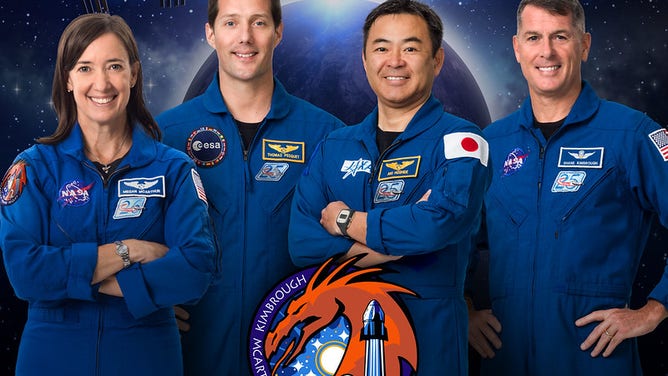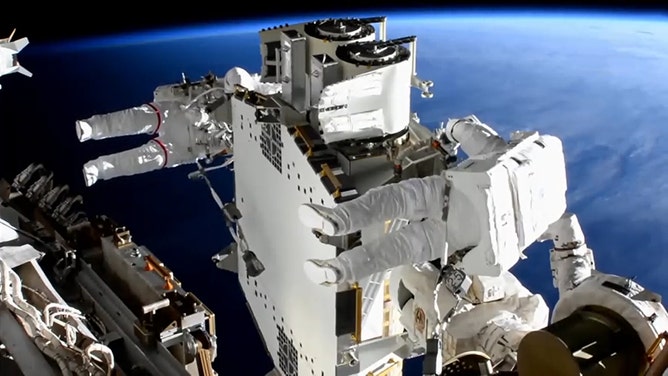Crew-2 astronauts describe jumping into action during space station emergency
While in space, the NASA, ESA and JAXA astronaut crew conducted a combined four spacewalks, grew chile peppers and responded to two ISS emergencies.

The official portrait of the SpaceX Crew-2 crew members. From left are, NASA astronaut and Pilot Megan McArthur; European Space Agency (ESA) astronaut and Mission Specialist Thomas Pesquet; JAXA (Japan Aerospace Exploration Agency) astronaut and Mission Specialist Akihiko Hoshide; and NASA astronaut and Commander Shane Kimbrough.
(NASA)
A week after returning to Earth, the four Crew-2 astronauts described their eventful six-month stay in space, including responding to two unexpected space station emergencies.
On Monday, NASA hosted a question and answer session with NASA astronauts Shane Kimbrough and Megan McArthur, Japan Aerospace Exploration Agency astronaut Akihiko Hoshide, and European Space Agency astronaut Thomas Pesquet.
The astronauts launched in SpaceX's Dragon Endeavour to the space station in April. Dragon returned to Earth on Nov. 8, splashing down in the Gulf of Mexico near Pensacola, Florida.
Dragon riders reflect on SpaceX experience
Hoshide compared his previous spaceflights with the space shuttle and Russia's Soyuz spacecraft, which ended with ground landings, to his return with Dragon.
"We have experienced the land landing. And compared to that, splashdown (it) was much, much softer, I would say. But I was worried after splashdown and if, you know, bobbing on the surface of the ocean, and that would make me sick," Hoshide said.
The Japanese astronaut said no one onboard Endeavour got seasick, and the astronauts spent their time waiting for the recovery teams reflecting on their journey home.
Dragon arrived home barreling through Earth's atmosphere at more than 350 mph before plopping down in the Gulf at 15 mph, aided by SpaceX's parachute system.
One of the four main parachutes was slow to deploy. Teams quickly brought the chute back to Cape Canaveral to examine, and mission managers were confident enough to proceed with the Crew-3 launch less than 48 hours later.
'We relied on our training'
While on the station, the astronauts also had to respond to their first emergency in July when a newly docked Russian lab called Nauka began firing its thrusters uncontrollably.
Kimbrough described how the crew jumped into action when the alarms sounded on the space station.
"We showed up, and Aki (Hoshide) started giving us roles and responsibilities to react to the situation. And everybody kind of fell in line with our training and just started reacting his leadership," Kimbrough said of Hoshide, who was station commander at the time of the incident.
The thrusters caused the station to spin, creating a problem with communications from ground control.
"We were pretty much controlling the space station because the ground couldn't send the commands due to our tumbling sensation that we were going through there. The communication just wasn't great for the ground to be able to talk to the space station. So we had to do it," Kimbrough said. "We relied on our training, and it just kind of kicked in. The stuff that we thought we'd never, ever use we were using."
About a half-hour later, the station was back in its correct position, according to NASA. The astronauts went through many debriefings to try and understand what went wrong and prevent future incidents.
Kimbrough said the crew thought they "would never, ever get to do that again."
However, another incident happened in October when a Russian Soyuz spacecraft fired its thrusting longer than expected, tilting the station. Within 30 minutes, flight controllers regained attitude control of the space station, according to NASA. The space agency says the crew was not in any danger during either incident.
Spacewalking and space gardening

On June 20, 2021, spacewalkers Shane Kimbrough (foreground) and Thomas Pesquet work to prepare the second roll-out solar array for installation.
(NASA / FOX Weather)
While on station for nearly 200 days, the astronauts conducted three spacewalks to install two new roll-out solar arrays beginning a power upgrade for the 21-year-old International Space Station's power grid.
Pesquet and Kimbrough had previously spacewalked together on another mission.
"We go way back as far as spacewalking together," Pesquet said.
The trio of spacewalks was challenging, explained Pesquet, for several reasons. One, because of deploying the arrays that are rolled up like carpets designed to unfurl in space. Another because of where the astronauts had to get to outside the ISS to attach the arrays.
"We jokingly called it the wild, wild west of the space station because it was all the way at the end of the truss where nobody ever goes," Pesquet said, adding there are fewer handrails to grab on to, making it a "really challenging environment."
Four more arrays need to be launched and installed on the ISS to complete the upgrade.
McArthur said the crew all enjoyed looking out the space station cupola down at Earth. Her last spaceflight was the final Hubble Space Telescope repair mission in 2009 onboard the space shuttle. Hubble is 353 miles above Earth versus the station's orbit of around 200 miles.
"There's definitely a difference that I noticed right away the first time I came into the cupola to observe the earth," she recalled. "I thought, 'wow, we are really close,' because when you are on a Hubble mission, it's quite a bit higher up. And so you're seeing more of the curvature of the Earth. But then I quickly grew to love the view that I had because you can see so much more detail."
The astronauts were busy keeping up with the many ongoing experiments on the orbiting laboratory, but they did have a few favorites.
Kimbrough said he was interested in the Ring Sheared Drop experiment examining fibrous amyloids found in organs and tissues associated with neurodegenerative diseases, including Alzheimer's.
"So that's something that's hit my family. I'm sure it's hit many other people's families. And so it was near and dear to me," Kimbrough said. "I was glad to be a part of the experiments, and then hopefully, a few years down the road, we'll get the results. And hopefully, they're all positive for helping treat and maybe cure those diseases."
McArthur also had a personal connection to another experiment: growing chile peppers in space. She said she learned "my brother-in-law's uncle was actually the creator of the specific variety that we were growing."
"So that was really fun for my family to discover that. And then everybody, you know, was following along in the development of the peppers," McArthur said.
When the chile peppers were ready, the astronauts had a taco night on the space station, enjoying some of their harvests.
Now a week out from their splashdown, the astronauts are assimilating to life with gravity. Despite six months with each other in space and months of training prior, the astronauts said one of the hardest parts of returning was not having their crewmates there all the time.
Kimbrough said he finds himself waking up and wondering where the other astronauts are.
"Those are the faces you see every morning as soon as you get up, or if you need something, that's who you go to. So it's been a little adjustment," Kimbrough said. "I just miss being with them, honestly, because our friendship has grown very deep over the last six months."
Back on the other side of the Atlantic Ocean in Europe, Pesquet agreed, telling his fellow crew via video chat, "miss you." To which Kimbrough replied, "you too."